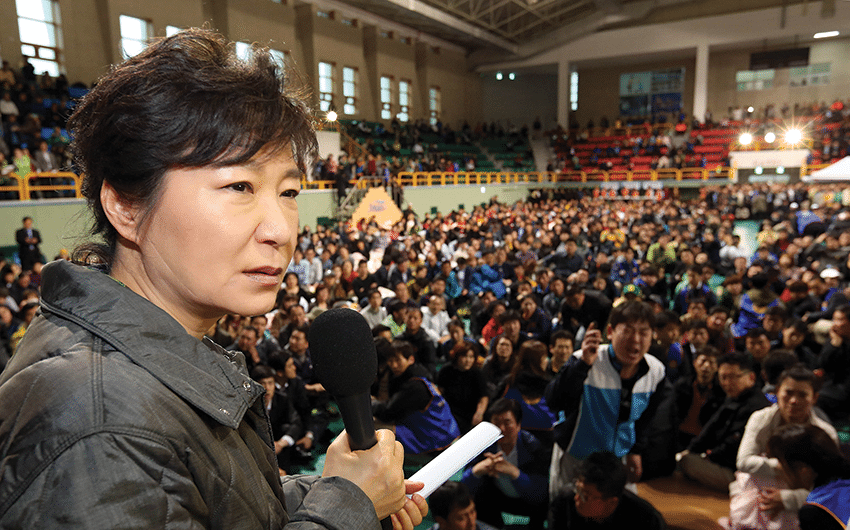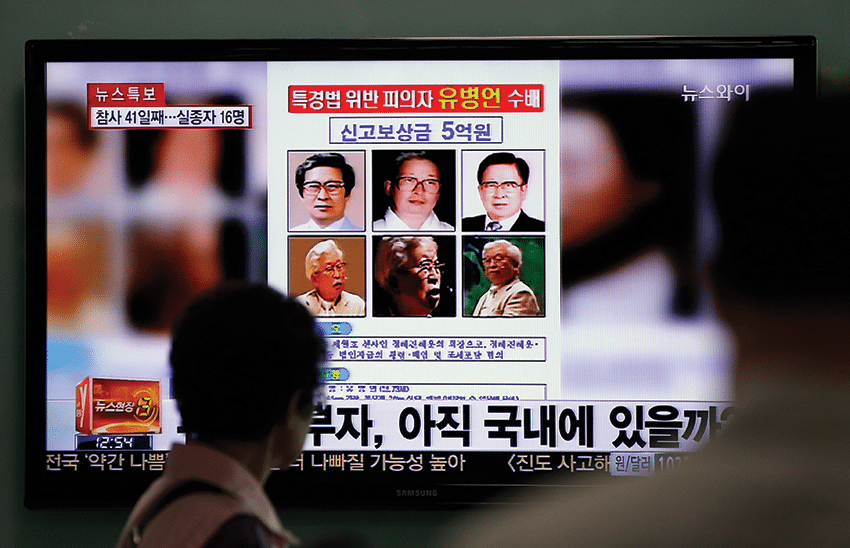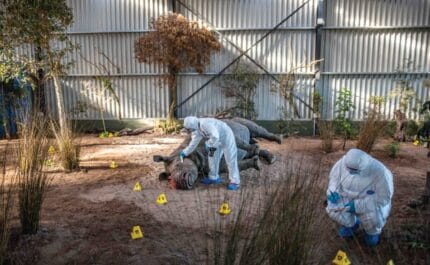“The root cause of calamity”
On 16th April 2014, the MV Sewol capsized and sank off the South Korean coast killing more than 300 people, mostly children. When grief turned to anger, the public wanted someone to blame. The government pointed the finger at Yoo Byung-eun, a reclusive artist, religious leader and wealthy industrialist it claimed secretly ran the company that owned the sunken ship. Back in August 2014, Matthew Lee told the extraordinary story of the ‘millionaire without a face’

Photo: Ahn Young-joon/AP/Press Association Images
16th April 2014 (Taken from: #15)
The body of South Korea’s most wanted man was found in a plum orchard in Suncheon on 12th June 2014. It was so badly decomposed that it took police six weeks to confirm it was Yoo Byung-eun, industrialist, inventor, photographer, religious leader – and the man accused of secretly running and disastrously mismanaging the company that owned the MV Sewol, the passenger ferry that capsized in April, killing more than 300 people.
The police initially suspected the body belonged to a homeless person. When they confirmed its DNA closely matched that of Yoo’s brother’s on 22nd July, they had to admit to a spectacular error of judgement. There was no shortage of clues that the target of South Korea’s largest ever manhunt had been found; the body was wrapped in a $10,000 Loro Piana parka and was wearing custom-made shoes. Next to the body – along with three empty bottles of soju, a Korean rice wine, and a bottle of shark liver oil manufactured by one of Yoo’s companies – was a copy of a book written by the deceased. Yoo had been found only 2.5 kilometres from his holiday home. Six weeks and billions of taxpayer won had been wasted turning the country upside down when he had already been found. “The incompetence of police and prosecutors is simply astounding,” declared Chosun IIbo, one of South Korea’s top-selling papers.

Yoo Byung-eun, the man accused of mismanaging the MV Sewol. Photo: Ahn Young-joon/AP/Press Association Images
The hunt for the 73-year-old began when prosecutors alleged that, through a murky network of cross-holdings, Yoo was patriarch of the family that controlled Chonghaejin Marine, the shipping firm that operated the MV Sewol. A week after the disaster, both Yoo’s home and Chonghaejin Marine’s offices were raided by investigators searching for evidence of his involvement. An arrest warrant was issued a month later. Yoo was accused of embezzlement, tax evasion and negligence in relation to the Sewol disaster; a 500 million won (£294,000) reward was offered to anybody with information leading to his arrest. His 47-year-old daughter was detained in Paris and faced extradition, but her famously reclusive father managed to evade the authorities. Wanted posters went up all over the country. The image of the publicity-shy tycoon widely known as ‘the millionaire without a face’ was suddenly everywhere.
The day before Yoo’s body was found, 6,000 police officers, many in full riot gear, raided the headquarters of the Evangelical Baptist Church in Anseong, 50 miles south of Seoul. The fugitive, they believed, was being hidden by the followers of the church he had founded. But they were wrong. Yoo had already been dead for almost a fortnight, and until his death he’d been hiding in a small cabin with little more for company than a suitcase containing 830 million won (£490,000) in cash. We still don’t know whether it was suicide or murder.

Relatives of missing passengers watch a TV news programme reporting government rescue operations at a gymnasium in Jindo, South Korea. Photo: Ahn Young-joon/AP/Press Asociation Images
Sewol is the most shocking and devastating disaster in modern South Korean history. This is largely because it was so easily avoidable, but also because of the high number of child victims.
On 16th April, 340 pupils and staff of Danwon high school boarded the MV Sewol at the port of Incheon to take a field trip. Only 75 would survive it. The visit to Jeju island, famed for its sandy beaches, palm trees and spectacular volcanic landscapes, was supposed to be a treat for the teenagers before they had to start cramming for exams. Twelve hours into the journey, near the southern tip of the South Korean mainland, the ship began to capsize. Only a small number of passengers were rescued.
The school’s deputy headteacher, Kang Min-kyu, was one of them, but two days after the incident he was found hanging from a tree on Jindo island, close to where the boat went down. There was a suicide note in his pocket: “Please put all the blame on me. I pushed ahead with the school trip. I will once again become a teacher in the afterlife for my students whose bodies have not been discovered.”

South Korean coast guard officers rescue MV Sewol’s Captain Lee Joon-seok, wearing a sweater and underwear, from the sinking ferry. Photo: AP/Press Association Images
Public anger at the needless deaths of so many children was understandably enormous. At first it was mostly targeted at the crew, especially the 69-year-old captain, Lee Joon-seok. People were incredulous that someone with more than 40 years of experience at sea could be capable of such wanton negligence; in turbulent waters he’d left control of the ship to an inexperienced 25-year-old, and when the boat was sinking he delayed its evacuation and told passengers to stay put, a decision with disastrous consequences.
Worst of all, he put the lives of himself and his crew before those of his passengers, violating international maritime protocol, if not the law. When South Koreans saw a video of Lee, wearing only his sweater and his underwear, receiving treatment on a rescue boat while hundreds of children remained trapped on the Sewol, they were appalled. More than two-thirds of the crew survived; only a third of passengers did. President Park Geun-hye said the “actions of the captain and some crew members were utterly incomprehensible, unacceptable and tantamount to murder”.
Yet Park herself wasn’t immune to criticism. The rescue operation had been a failure. The government was forced to apologise for its sluggish response and prime minister Chung Hong-won resigned. As further details on the MV Sewol emerged – it was carrying more than three times its cargo limit, its staff had barely received any safety training, it had been carelessly modified to carry an extra 150 people – it became increasingly clear that a lack of regulation and enforcement was partly to blame.

South Korean president Park Geun-hye speaks at
a gymnasium in Jindo during a meeting with parents whose children are missing, Thursday 17th April, 2014. Photo: Do Kwang-hwan/AP/Press Association Images
The crowds outside the court in Gwangju shouted “murderer” at Lee Joon-seok when he arrived for initial hearings. Inside court, his lawyers argued that while he had made mistakes, he couldn’t do anything about his employer’s policy of overloading the ships with cargo. His employer, the public also learned, had used fake documents to get its license from the Korean Register of Shipping and had only spent $500 on safety education in the whole of 2013. When the investigators’ trail led to the person they believed was the real owner of Chonghaejin Marine, President Park didn’t mince her words. “The Yoo Byung-eun family is the root cause of this calamity,” she said.
The biggest shareholder in Chonghaejin Marine is a company called Chonhaeji. The biggest shareholder in Chonhaeji is a company called I-One-I Holdings. I-One-I Holdings is a holding company of the Semo Group, which was founded by Yoo Byung-eun in 1979. Semo made its money through soap and cosmetics, and soon moved into numerous other industries including shipping. The company thrived during the country’s economic ‘miracle’ of the 1980s but a series of accidents (14 people died in a cruise boat crash in 1991) and scandals (Yoo spent four years in prison for fraud) took its toll and Semo declared bankruptcy at the start of the Asian financial crisis in 1997.
Not that bankruptcy would slow Yoo down. He rebuilt his empire with the minimum possible transparency; neither his nor his children’s names were on any documents linking them to Chonghaejin Marine. When the government blamed Yoo for Sewol he was forced to issue a denial. His New York spokesperson, Michael Ham, said Yoo “was shocked and deeply saddened” by the incident but did “not have any involvement in the management or day-to-day operations of Chonghaejin”. He didn’t have time to run a business, Ham added, because he had spent “every single day of the past four to five years” as alter ego Ahae, staring out of a window taking photographs.

Wanted posters for Yoo Byung-eun offering a 500 million won reward for information leading to his arrest. Photo: Lee Jin-man/AP/Press Association Images
According to the ahae.com website, the mysterious Korean industrialist known as Ahae – an old-fashioned Korean word for ‘child’ – took more than 2.6 million photographs between 2009 and 2013. That’s around 2,000 photographs a day, or 80 an hour not accounting for sleep or toilet breaks, taken from the exact same spot, a small studio in a disused aircraft hangar in the South Korean countryside.
The photos showed birds landing on branches, ripples on the surface of a pond, trees shedding leaves and growing them again. They weren’t anything special, yet they were exhibited at Grand Central Station in New York, Clarence House in London, the Palace of Versailles and the Louvre in Paris, where Ahae has his name etched in stone thanks to his large donations. Ahae clearly liked France, even if he never visited it – a month before his Louvre exhibition he purchased Courbefy, an abandoned French village. A year later, he hired British composer Michael Nyman to write a symphony for him. ‘Symphony No.6 – Ahae: Through the Only Window’ was performed by the London Symphony Orchestra.
Press releases for Ahae included no portraits of the artist, who refused to give interviews or attend his own exhibitions, but they did include a biography. Ahae, they explained, was an inventor, an entrepreneur, a philanthropist, an environmental activist, a martial artist, a painter, a sculptor, a poet and a photographer. He was a master of taekwondo and judo, and had created his own discipline of self-defence. He was responsible for more than 1,000 inventions including numerous household items, health tonics, an award-winning colon cleansing device and several boats. He had sold his photographs for huge sums. They didn’t mention that his main clients were Chonghaejin Marine and the Evangelical Baptist Church of Korea.
Members of the Evangelical Baptist Church are known as Salvationists. Ever since President Park vowed to track down their founder and mentor they’ve insisted it’s a witch-hunt, a campaign against an innocent scapegoat to distract attention from a botched rescue effort and serious structural failures in the shipping and transport industries. Even now, some Salvationists refuse to believe that Yoo is dead. Why, they asked, would an avowed teetotaler be carrying three bottles of soju?

Police raid the Evangelical Baptist Church on 11th June 2014. Photo: Shin Young-geun/AP/Press Association Images
The church was founded in the early 1960s by Yoo and his father-in-law, and it now claims 100,000 members. Whether it’s a religion or a cult is a topic of fevered debate – its doctrine, at least when compared with other Korean religious movements such as that of Reverend Moon’s Unification Church, isn’t particularly unusual. Salvationists reject the notion of repentance and place a great emphasis on health and cleanliness – it’s no coincidence that Yoo invented a portable enema device, used to cleanse Salvationists’ bodies of impurities.
In 1987, Yoo was arrested following the deaths of 32 people, allegedly cultists linked to his church who had been involved in an apparent suicide pact. Several of the victims had funnelled funds to Yoo, who denied involvement and was later cleared of any connection to the deaths, although it did lead to a fraud conviction and a four-year prison sentence. His crime was defrauding members of his church and using their money to fund his numerous business ventures, including Semo. In the weeks after Sewol, prosecutors alleged that church money had been used to prop up the debt-ridden Chonghaejin Marine.
When 6,000 police stormed the Evangelical Baptist Church compound to search for Yoo, a group of Salvationists reportedly blockaded the entrance, vowing to die as martyrs to protect their leader. It may or may not be a cult, and they may or may not have admired his photography, but Yoo certainly inspired loyalty.
A day later, the police finally got their man – not that they knew it at the time. Yoo was rotting in the weeds, protected by no one. A millionaire without a face, mistaken for a homeless person.
Slow Journalism in your inbox, plus infographics, offers and more: sign up for the free DG newsletter. Sign me up
Thanks for signing up.








